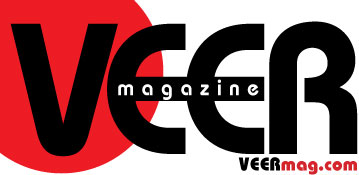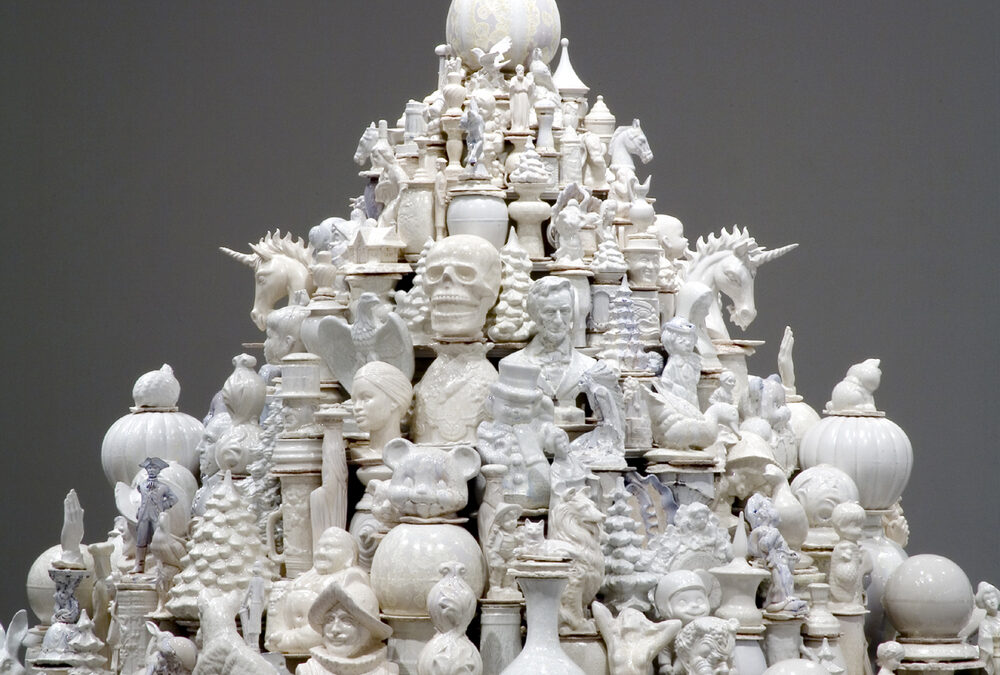(Walter McConnell’s “Theory of Everything.” Courtesy of the artist and Cross MacKenzie Gallery.)
By Betsy DiJulio
From the shelves of the local dollar store to the rarefied environs of the world’s most prestigious museums, ceramics run the gamut and are ubiquitous features in our lives. But, other than potters or collectors, most people don’t think too much about these humble wares. And therein lies the entry point of The Vessel Revisited. Revisited = Rethought.
Curated in-house at the Torggler, the show boasts 8,000 square feet of real estate and 74 objects by 18 artists, all of whom are based in the US, but of diverse global backgrounds. As associate curator, Lucas Matheson, says, the premise of the show was a “simple desire” of his and executive director, Holly Koons’s: “We wanted to do a ceramics show.”
But, as with all exhibitions at the Torggler, they wanted the pieces they chose to intersect with substantive art historical and curatorial questions. As a result, several throughlines connect the range of works in the show: utility vs. artistry or “low” vs. “high” art and culture; East meets West; ancient origins and contemporary relevance; value, both in terms of monetary worth and significance; and cultural identity.
One of the related questions embedded in this exhibition, which wraps together several of these threads and has long vexed critics, is the classification of objects, especially those that may be functional—vases, bowls, cups, amphoras, etc.—but which are considered “art” by their creators. An artist like Marcel Duchamp threw down the gauntlet when, in 1917, he submitted an inverted porcelain urinal on a pedestal entitled “Fountain” to the Society of Independent Artist where it was handily rejected.
Considered a pivotal moment in art history and a precursor to conceptual art, Duchamp raised the aesthetic question of where the “art-ness” of an artwork lies. Is it in the object itself? Or is it in the maker, the context, the viewer, or some combination? His subversive act would suggest that he is not aligned with the first.
After speaking with Matheson about the overarching and underlying themes of the show, I caught up with Koonz with a “simple desire:” for her to share three not-to-be-missed artists or works with VEER readers.
Her first selection, “A Theory of Everything” by Walter McConnell, is a towering example of elevating the mundane to fine art just for starters. Assembled on site from 1,000 ceramic objects by the artist and assistants over the course of nine days, the stupa-like form consumes the entire back section of the gallery. Not attached to each other, the pieces are numbered to match a location on an architectural framework of concentric circles, though the artist adjusts on site.
Cast from purchased slip molds, many from China, each vessel and tchotchke was designed to appeal to a mass tourist market. The cross-cultural and commercialized pieces range from vases to animals, holiday symbols, presidents and religious figures. Fired to different temperatures, the zinc-based glaze develops different tones and textures with a great deal of subtlety.
The work of Sin-Ying Ho is an elegant example of the East meets West theme, among others. This global artist was born in Hong Kong, immigrated to Canada—earning her BFA in Nova Scotia and her MFA at Louisiana State University—and now resides in New York City. Koons describes her work, steeped in Ming Dynasty ceramic techniques—especially their blue and white porcelain—as an “almost Cubist compilation of vessels.”
Somewhat difficult to envision without seeing them in person, the elegant vessels are incomplete—“amalgamated”—and serve, in part, as a symbol of Ho’s own identity. Portions of the pieces bear the traditional Asian blue and white decorative treatment, while others are decal printed with recognizable American pop culture images appropriated from Andy Warhol.
Represented by one very large vessel is the work of Roberto Lugo. This Puerto Rican-American ceramicist is just as likely to be found with a portable wheel on the sidewalk teaching inner city dwellers to throw pots as inside the walls of a museum. Social activism, spoken-word poetry, hip-hop culture, history, politics, and his cultural background merge in his work in which resolutely handmade traditional ceramic forms are richly glazed with iconic Black and Latino figures and colors and patterns inspired by graffiti traditions and Mexican pottery.
The piece in the Torggler’s exhibition features a portrait of Satchel Paige. A baseball player with household name recognition, Paige is known for several firsts: he was the oldest rookie in MLB history at age 42, the first African American to pitch in the World Series, and the first Black player inducted into the Baseball Hall of Fame in 1971. A clever example of visual wordplay, this piece offers us a pitcher on a pitcher.
And The Vessel Revisited offers a testament to what someone somewhere said, “Clay and fire, they teach us.”
WANT TO SEE?
The Vessel Revisited: Fundamental Forms in Contemporary Ceramics
Through August 10
Torggler Fine Arts Center, Christopher Newport University
1 Avenue of the Arts, Newport News,




